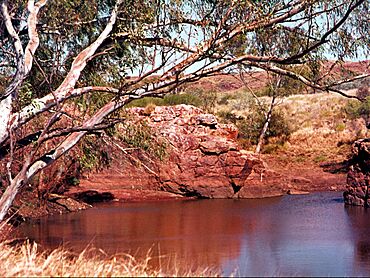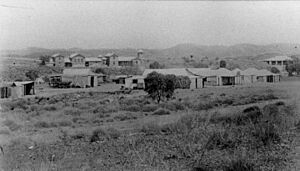Marble Bar, Western Australia facts for kids
Quick facts for kids Marble BarWestern Australia |
|||||||||
|---|---|---|---|---|---|---|---|---|---|

Chinaman's Pool, 1976
|
|||||||||
| Established | 1893 | ||||||||
| Postcode(s) | 6760 | ||||||||
| Elevation | 178 m (584 ft) | ||||||||
| Area | [convert: needs a number] | ||||||||
| Location |
|
||||||||
| LGA(s) | Shire of East Pilbara | ||||||||
| State electorate(s) | Pilbara | ||||||||
| Federal Division(s) | Durack | ||||||||
|
|||||||||
Marble Bar is a town in the Pilbara region of north-western Western Australia. It's also known for a special rock formation. Long ago, in the early 1900s, it was a very important place for settlers. It was built even before other towns like Port Hedland.
This town is famous for its super hot weather. It has the second highest average maximum temperature in Australia. Only Wyndham is hotter.
Scientists have also found amazing old fossils nearby. These fossils are called stromatolites. They are one of the earliest forms of life on Earth. These ancient fossils are about 3.5 billion years old!
History of Marble Bar
Marble Bar was once the main hub of the Pilbara region. It was settled before many other towns like Port Hedland and Newman.
Gold Discovery and Town Naming
The town officially started in 1893. This was after gold was found there in 1890. A prospector named Francis Jenkins found the gold. The town's main street is named after him.
The name "Marble Bar" comes from a nearby rock formation. It's a jasper bar that crosses the Coongan River. People first thought it was marble, but it's actually jasper.
Gold Rush Excitement
In 1891, the town grew very fast. More than 5,000 people came hoping to find gold. Many large gold nuggets were found during this gold rush.
- The Little Hero nugget weighed 333 ounces.
- The Bobby Dazzler weighed 413 ounces.
- The General Gordon nugget weighed 332 ounces.
These huge nuggets were all found near Marble Bar.
Historic Buildings in Town
By 1895, the town had its own government offices. These buildings are made from local stone. They are still standing today and are protected by the National Trust of Australia.
The town's Ironclad Hotel was built in the 1890s. It's made of corrugated iron. American miners gave it its name. They thought it looked like the Ironclad ships from the United States. This hotel has been a heritage site since 2006.
Connecting with the World
A telegraph line was planned in 1893. It was meant to connect Condon to Marble Bar. This was very important for the gold mines. They needed to talk to other places, even England.
After some delays, the line was finished in July 1894. A Post and Telegraph Office opened soon after. This helped the town stay connected.
Marble Bar During World War II
During World War II, a military airfield was built near Marble Bar. It was about 25 kilometres (16 mi) away at Corunna Downs Airfield. American and Australian air forces used this base.
They flew heavy bombers from here. These planes attacked Japanese forces. Some missions went as far as Borneo.
The Old Railway Line
The Port Hedland to Marble Bar Railway opened in 1911. It cost about £300,000 to build. This was a lot of money back then.
However, not many people or goods used the railway. It also lost a lot of money. So, it closed down on May 31, 1951. This old narrow gauge line was a early version of the big iron-ore railways we see in the Pilbara today.
Climate in Marble Bar
Marble Bar has a hot desert climate. This means it has extremely hot summers and warm winters. Most of the rain falls during the summer months.
World Record Heat
Marble Bar holds a world record for heat. It had 160 days in a row where the temperature was 100 °F (37.8 °C) (about 37.8°C) or higher. This happened from October 1923 to April 1924.
In December and January, temperatures often go above 45 °C (113 °F). The average highest temperature is hotter than normal human body temperature for six months each year. Marble Bar has about 160 clear, sunny days every year.
Warm Winters and Rare Frost
Winters are warm, unlike most of the year. Days average around 27 °C (81 °F). The air is dry, and the skies are clear.
Nights from June to August can be cool. Sometimes it gets as low as 5 °C (41 °F). But it never gets cold enough for frost. Even in winter, it can get hot for a few days. Temperatures might reach 35 °C (95 °F) before cooling down again.
Rainfall Patterns
Rainfall in Marble Bar is usually low and unpredictable. Most rain falls between December and March. Sometimes, there's rain from autumn storms too.
Some years can be very dry, with only 71.1 mm (2.80 in) of rain. But during very wet seasons, the monsoon can bring a lot more. For example, 927.1 millimetres (36.50 in) fell between April 1999 and March 2000. In 1980, 797.9 mm (31.41 in) fell because of several tropical cyclones. The most rain in one month was 417.4 mm (16.43 in) in March 2007. The most in one day was 304.8 millimetres (12.00 in) on March 2, 1941.
| Climate data for Marble Bar, Western Australia | |||||||||||||
|---|---|---|---|---|---|---|---|---|---|---|---|---|---|
| Month | Jan | Feb | Mar | Apr | May | Jun | Jul | Aug | Sep | Oct | Nov | Dec | Year |
| Record high °C (°F) | 49.2 (120.6) |
48.3 (118.9) |
46.7 (116.1) |
45.0 (113.0) |
39.5 (103.1) |
35.8 (96.4) |
35.0 (95.0) |
38.0 (100.4) |
42.6 (108.7) |
46.0 (114.8) |
47.2 (117.0) |
49.3 (120.7) |
49.3 (120.7) |
| Mean daily maximum °C (°F) | 41.0 (105.8) |
39.8 (103.6) |
39.0 (102.2) |
36.0 (96.8) |
30.7 (87.3) |
27.1 (80.8) |
26.8 (80.2) |
29.6 (85.3) |
33.9 (93.0) |
37.6 (99.7) |
40.5 (104.9) |
41.6 (106.9) |
35.3 (95.5) |
| Mean daily minimum °C (°F) | 26.1 (79.0) |
25.7 (78.3) |
24.8 (76.6) |
21.4 (70.5) |
16.6 (61.9) |
13.2 (55.8) |
11.7 (53.1) |
13.3 (55.9) |
16.7 (62.1) |
20.3 (68.5) |
23.6 (74.5) |
25.5 (77.9) |
19.9 (67.8) |
| Record low °C (°F) | 17.9 (64.2) |
13.9 (57.0) |
15.0 (59.0) |
10.0 (50.0) |
5.6 (42.1) |
1.1 (34.0) |
2.2 (36.0) |
3.9 (39.0) |
5.6 (42.1) |
10.0 (50.0) |
14.4 (57.9) |
17.0 (62.6) |
1.1 (34.0) |
| Average rainfall mm (inches) | 76.3 (3.00) |
87.8 (3.46) |
56.7 (2.23) |
21.9 (0.86) |
23.0 (0.91) |
23.0 (0.91) |
12.6 (0.50) |
6.4 (0.25) |
0.9 (0.04) |
3.8 (0.15) |
9.1 (0.36) |
39.6 (1.56) |
361.1 (14.23) |
| Average rainy days (≥ 0.2 mm) | 7.4 | 7.7 | 4.9 | 1.9 | 2.4 | 2.3 | 1.5 | 0.9 | 0.3 | 0.6 | 1.5 | 4.6 | 36 |
| Average afternoon relative humidity (%) | 26 | 31 | 26 | 23 | 27 | 28 | 24 | 21 | 17 | 16 | 16 | 20 | 23 |
| Source: Australian Bureau of Meteorology | |||||||||||||
Ancient Life: Geological History
Near Marble Bar, scientists have found amazing fossilised stromatolites. These are some of the very first forms of life on Earth. They are about 3.5 billion years old! This was during the Paleoarchean era. Back then, these tiny organisms helped create the oxygen we breathe today.
The North Pole Site
There's a place nearby called North Pole. Its rocks contain special stromatolites. Some scientists believe these rocks show that life on Earth started 3.4 to 3.5 billion years ago.
This idea has been debated by scientists for a long time. Some argue that very old stromatolites might not have been made by living things. They suggest other natural processes could have formed them.
New Discoveries and Mars Missions
A scientist named Abigail Allwood has done a lot of research at the North Pole site. Her work seems to confirm that these ancient patterns were indeed made by living organisms.
Her research led to the creation of PIXL technology. This tool helps confirm her findings. PIXL is now a key part of the Mars 2020 Mission. It helps scientists look for signs of ancient life on Mars!



